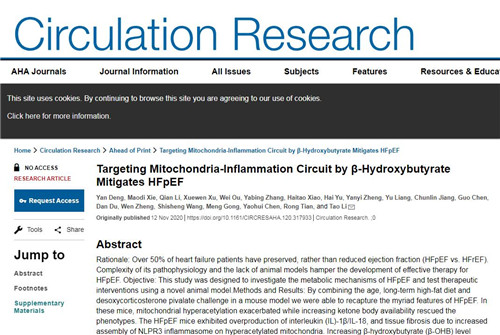
On November 12, Prof. Li Tao’s team of Laboratory of Mitochondria and Metabolism and Department of Anesthesia of West China Hospital published a research paper online entitled Targeting Mitochondria-inflammation Circuit By β-hydroxybutyrate Mitigates HFpEF in the internationally renowned medical journal Circulation Research (IF: 14.467), revealing the mechanisms of HFpEF pathogenesis. Prof. Li Tao of WCH and Prof. Tian Rong of University of Washington (Seattle) are the corresponding authors, Deng Yan, Xie Maodi, Li Qian and Xu Xuewen are the co-first authors, and WCH is the first author institute.
More than half of heart failure patients suffer from heart failure with preserved ejection fraction (HFpEF), without known pathogenesis. The research group first constructed a new HFpEF animal model through “3-Hit” (long-term high-fat diet exposure, pro-inflammatory drugs and aging). Moreover, based on the 13C-NMR, modified proteome, seahorse and other techniques, the mitochondrial hyperacetylation accelerated the assembly of NLRP3 inflammatory bodies and induced myocarditis and fibrosis, serving as the main pathological mechanism of HFpEF. Increasing the β-hydroxybutyric acid level of myocardial ketone body by supplementing ketone ester or SGLT2i can improve the myocardial mitochondrial function and inflammation, and relieve HFpEF symptoms. This study not only revealed the pathogenesis of clinical HFpEF, but also provided potential intervention targets.
Over 50% of heart failure patients have preserved, rather than reduced ejection fraction (HFpEF vs. HFrEF). Complexity of its pathophysiology and the lack of animal models hamper the development of effective therapy for HFpEF. This study was designed to investigate the metabolic mechanisms of HFpEF and test therapeutic interventions using a novel animal model. By combining the age, long-term high-fat diet and desoxycorticosterone pivalate challenge in a mouse model we were able to recapture the myriad features of HFpEF. In these mice, mitochondrial hyperacetylation exacerbated while increasing ketone body availability rescued the phenotypes. The HFpEF mice exhibited overproduction of interleukin (IL)-1β/IL-18, and tissue fibrosis due to increased assembly of NLPR3 inflammasome on hyperacetylated mitochondria. Increasing β-hydroxybutyrate (β-OHB) level attenuated NLPR3 inflammasome formation and antagonized proinflammatory cytokines-triggered mitochondrial dysfunction and fibrosis. Moreover, β-OHB downregulated the acetyl-CoA pool and mitochondrial acetylation, partially via activation of citrate synthase and inhibition of fatty acid uptake. Therefore, we identify the interplay of mitochondrial hyperacetylation and inflammation as a key driver in HFpEF pathogenesis which can be ameliorated by promoting β-OHB abundance.